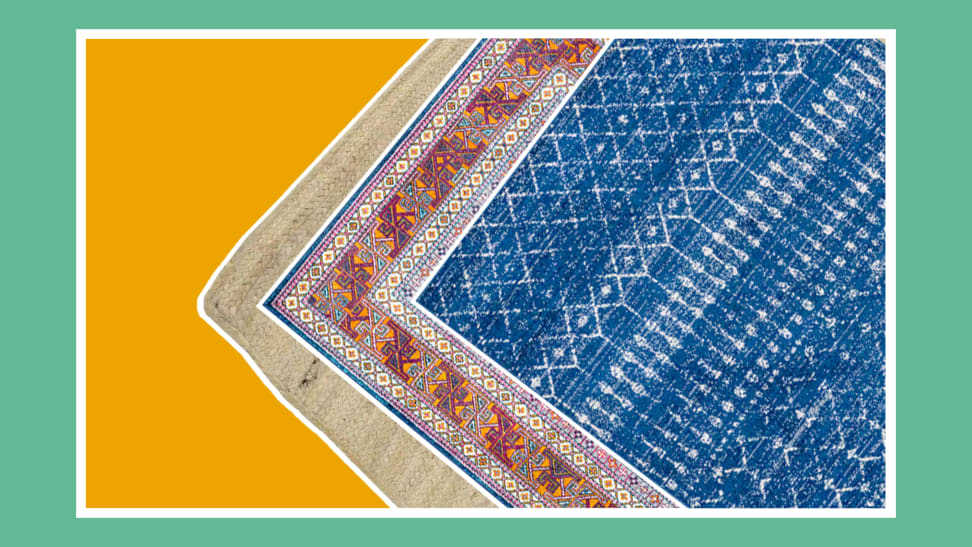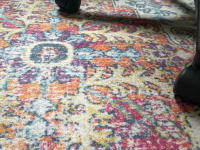4 expert design tips for layering rugs the right way
From neutrals to patterns, here's how to layer rugs in any room
 Credit:
Reviewed / Rugs.com
Credit:
Reviewed / Rugs.com
Products are chosen independently by our editors. Purchases made through our links may earn us a commission.
Figuring out how to layer rugs is one of the best and easiest ways to dress up your floors—and you can easily shop many stylish rug options online. You may be wondering what size rugs and what textures work best together, which is why we went straight to the experts to find out how to layer rugs at home.
“Layered rugs have been around for centuries but feel so modern,” says Samantha Gann, director of marketing at Rugs.com. “By layering a larger rug with a smaller one, you can easily add color, texture and personality to a room.”
Here are four designer tips for how to layer rugs in any room of your home.
1. Start with a neutral-colored rug as the base

If you're planning on going big and bold with the other rug layers moving forward, begin with a neutral base—for the sake of simplicity.
A favorite technique of interior designers, DIYers, and home decor aficionados, starting with a neutral-colored base rug is a simple way to get the look you want without breaking the bank.
“Vintage and antique rugs can often be expensive, especially if you need a floor covering large enough to fill a big living room, bedroom or dining room,” says Gann. “Buy an affordable large base rug and layer with the more expensive rug to get the same look and feel you are going for in the room.”
Gann suggests beginning with a large jute rug, what she calls “the do-it-all rug” that looks with any pattern and is just as good in formal rooms as it does in casual spaces.
A common base layer rugs thanks to its neutral hues, the natural material is also resistant to dirt, making it ideal for high-traffic areas.
2. Select the right size rugs to mix and match

The key to rug layering is buying the right corresponding sizes so that each of them can be featured and not appear cluttered.
There’s no concrete rule about the different size rugs that you can mix and match. Gann says getting the right rug combination often depends on the size of the room and the furniture placement.
“If you’re decorating a large space and want a rug combination that is tried and true, choose a 9x12 rug base and layer with a 5x7 rug,” she explains. “For most bedrooms, we recommend 8x10 for queen beds and 9x12 for king beds for the larger rug and then layer with a runner next to the bed, so you can get out of bed with a soft rug underfoot.”
But don’t worry about always layering a smaller rug with a larger rug. Just adjust the top one’s position a bit.
“If you have rugs that are similar in size, layer the top rug at an angle,” she explains.
If you have a room that you want to feel collected over time, layer two (or more if you are daring!) of the same style in coordinating colors. You can also try adding an oval-shaped rug on top of a large rectangular rug to add more depth to your space.
“I love mixing two red vintage Persian rugs that are similar but not the same for a bohemian design.”
Vintage Persian rugs like this red and black option from Wayfair, or this Persian-style rug from Pottery Barn, are stylish flooring options.
3. Pile on the prints

Prints and patterns are not only fun to experiment with, but they also can add character to a room.
Once you have your base rug selected, you have the freedom to choose any rug style, color or print for a look that captures attention.
The most interesting rug combinations are ones that take a little courage but also deliver the biggest impact.
“Try a heavily printed rug like a Persian rug as the base and layer it with a striped rug on top,” says Gann. “Or choose two Moroccan rugs, one with lots of color as the base and pair with a simple black and white print for the top rug.”
Another favorite combination is a colorful tribal rug paired with a rich Oriental rug, and if you’re in love with the Coastal Grandmother trend, try a large Jute rug with a classic flat weave cotton Chindi rug in a timeless stripe.
For a modern twist, throw the design rules out the window and experiment with styles you like.
“If you mix a natural texture like jute with a high-end Persian rug the room will feel elevated and sophisticated,” she continues. “Another combination that works well is a Moroccan rug with an unexpected cowhide or zebra rug.”
One rule of thumb from Gann: When designers say animal print rugs go with everything, it’s true.
4. Don’t forget the rug pad

Rugs that slip and slide every time you walk over them are a nuisance more than anything.
Even though you are layering multiple rugs, it’s still a good idea to use a rug pad.
A non-slip rug pad is only necessary under the base rug and helps to secure the rug in place.
You don’t need to worry about adding additional rug pads under every subsequent rug. However, if you’re worried about your rugs sliding around, a removable rug tape can help hold them in place.
Can I layer rugs outdoors?

A jute rug can offer uniformity while alone, and variety when layered together with others.
Yes! Following the steps above, you can transform your cracked concrete patio or dirty brick pavers by layering on outdoor rugs. Make sure to choose an outdoor rug made from waterproof or water-resistant materials with a neutral color scheme to keep it free of mildew throughout the year. A washable outdoor rug, like Ruggabble Outdoor Rugs, are another option that are easy to clean during any season.
“We’re seeing more and more people adopt the trend for their outdoor spaces too,” Gann continues.
The trend isn’t just for backyards, either, Gann says. Front doors are even getting the treatment with an outdoor rug layered with a doormat.
“This is a fun and simple way to update your space with the colors of the season or holiday.”
Choosing a simple color scheme, like a black and white or jute base layer, is a great way to incorporate bold and bright colors and prints on top, especially if you’re going for a seasonal look you can rotate throughout the year.


